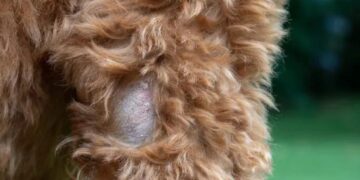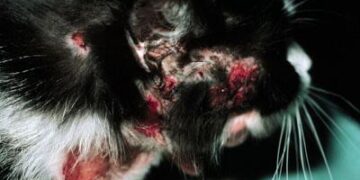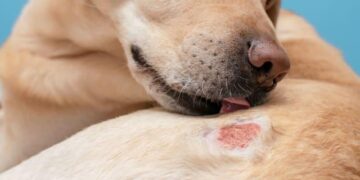Table of Contents
Introduction: The Case That Broke All the Rules, and My Practice With Them
I want to tell you a story about a dog named Max.
It’s a story I’ve carried with me for years, not because it was a remarkable medical mystery, but because it was so painfully ordinary.
Max was a beautiful Golden Retriever whose owner, a wonderfully dedicated woman named Sarah, brought him to my clinic for what seemed like a simple case of dry, flaky skin.
As a veterinarian in my early years of practice, I saw cases like Max’s every single day.
The protocol was second nature to me.
So, I started down the well-trodden path.
“Let’s try a good oatmeal shampoo,” I advised.
A week later, Sarah was back.
“The flakes are still there, and now he’s starting to scratch more.” My next move was just as predictable.
“It could be a food sensitivity.
Let’s switch him to a high-quality, ‘sensitive skin’ diet.” We did.
Sarah followed my instructions to the letter.
A few weeks later, she called, her voice tight with worry.
Max’s belly was now an angry red, and the scratching was relentless.
He had developed inflamed patches and even a few small sores from the constant irritation.1
We were now officially on the “itch-scratch-treat” merry-go-round.
We moved on to medicated shampoos and a short course of steroids to calm the inflammation.
It worked, for a little while.
But as soon as the medication stopped, the itch roared back with a vengeance.
The final straw came when the small sores blossomed into a full-blown secondary bacterial infection, a condition we call pyoderma.2
Max was miserable, Sarah was distraught, and I was deeply frustrated.
I had followed the textbook.
I had used all the standard tools in my arsenal.
And yet, I had failed Max.
The experience left me with a profound sense of inadequacy.
It wasn’t just that my treatments hadn’t worked; it was the realization that my entire approach felt fundamentally flawed.
I was playing a game of whack-a-mole with symptoms, patching holes in a dam that was cracking at its very foundation.
Max’s case forced me to confront a difficult truth: the conventional wisdom I had been taught was often not enough.
It compelled me to look beyond the surface—beyond the flakes, the redness, and the itch—and to search for a completely new way of understanding the very organ I was trying to treat.
The Itch-Scratch-Treat Merry-Go-Round: Why Standard Advice Fails
If you’re reading this, chances are you’ve been on that merry-go-round with your own dog.
You’ve bought the special shampoos, spent a small fortune on different foods, and maybe even gone through rounds of antibiotics or steroids, only to watch the problem come creeping back.4
It’s a cycle that leaves you feeling helpless and your dog feeling miserable.
I want you to know that your frustration is valid.
The reason this approach so often fails is that it’s designed to chase symptoms rather than address the root cause.
The Flaw of Symptom-Chasing
The visible signs of a skin problem—the dandruff-like flakes (seborrhea), the red and inflamed patches (dermatitis), the incessant scratching (pruritus), and even the secondary scabs and sores (pyoderma)—are not the disease itself.1
They are distress signals.
They are the smoke, not the fire.
When we focus only on quieting these signals, we ignore the underlying dysfunction that’s sending them.
Deconstructing Common Fixes
Let’s look at why the standard “fixes” often provide only temporary relief.
- The “Magic Shampoo” Myth: You’ve likely been told to use an oatmeal shampoo, and you’ve probably seen it help a little.4 Soothing shampoos with ingredients like oatmeal can provide temporary comfort by reducing inflammation on the skin’s surface.6 But a shampoo alone is like mopping a flooded floor without fixing the leaky pipe. It cleans up the immediate mess, but it does nothing to prevent the flood from happening again. As one owner on a forum noted, a dandruff shampoo helped for a few days, but then her dog was “back flaky”.4 The relief is fleeting because the underlying cause of the irritation remains untouched.
- The “Just Switch the Food” Fallacy: Diet is absolutely critical to skin health, but the advice to simply “switch brands” is an oversimplification. True food allergies, which are immune reactions to specific ingredients like beef or chicken, are a significant cause of skin issues for some dogs.1 For these dogs, a carefully managed elimination diet is necessary for diagnosis.2 However, many skin problems are not caused by a specific allergy but by broader nutritional deficiencies, such as an inadequate supply of essential fatty acids, or by poor-quality ingredients that promote inflammation.1 Simply swapping one bag of kibble for another without a strategic understanding of the nutrients involved is a shot in the dark.
- The Steroid and Antibiotic Trap: Drugs like corticosteroids (e.g., prednisone) and antibiotics are powerful and often necessary tools. They can be lifesavers for breaking the cycle of a severe allergic flare-up or clearing a nasty bacterial infection.5 The problem arises when they become the
only tool. Steroids suppress the immune system to reduce itching and inflammation, but they don’t fix what’s causing the immune system to overreact in the first place. Antibiotics kill the bacteria that have invaded damaged skin, but they don’t repair the skin to prevent future invasions. This can lead to a cycle of dependence, and the overuse of antibiotics is a growing concern in veterinary medicine due to the risk of creating resistant bacteria.3
The core issue with this reactive model is that it fails to recognize a crucial dynamic: the vicious circle of barrier dysfunction.
Healthy skin is a robust barrier.
When it becomes inflamed, that barrier weakens.
A weakened barrier allows more irritants, allergens, and microbes to penetrate the skin, which in turn triggers more inflammation.12
This creates a self-perpetuating cycle where the problem feeds itself.
The itch leads to scratching, the scratching damages the skin, the damaged skin lets in more irritants, and the irritants cause more itching.
Standard advice often targets just one point in this cycle, but it fails to break the cycle itself because it doesn’t address the fundamental integrity of the skin barrier.
The true goal isn’t just to stop the itch; it’s to rebuild the barrier.
The Epiphany: Your Dog’s Skin is Not a Covering, It’s a Fortress
My journey away from the “itch-scratch-treat” model began when I stopped seeing skin as a simple covering, like a leather jacket, and started seeing it for what it truly is: a dynamic, living fortress.
This concept, known in veterinary dermatology as the epidermal barrier function, was the paradigm shift that changed everything for me and my patients.12
Imagine your dog’s skin is a perfectly constructed brick wall, designed to protect the body’s internal environment from the harsh outside world.
This isn’t just a metaphor; it’s a remarkably accurate way to visualize how the skin works on a microscopic level.13
The Brick and Mortar Model Explained
This “fortress wall” is primarily composed of two critical elements, as described in veterinary dermatology research 13:
- The Bricks (Keratinocytes): These are the skin cells. They are the tough, durable, structural blocks that form the physical wall. They are tightly packed to create a formidable line of defense against physical damage and invaders.13
- The Mortar (Intercellular Lipids): This is the magic ingredient. In between every single brick, there is a rich, fatty “mortar” that holds everything together. This mortar is made of a precise mixture of lipids, with the most important being a class of molecules called ceramides.12 This lipid mortar does two vital jobs: it seals the gaps between the bricks to lock moisture
in, keeping the skin hydrated and supple, and it prevents allergens, bacteria, and yeast from getting out. - The Reinforcing Steel (Filaggrin): To take the analogy one step further, there are specialized proteins, most notably one called filaggrin, that act like reinforcing steel within the bricks themselves. Filaggrin helps the keratinocyte cells mature properly and flatten out to form the strong, resilient outer layer of the fortress wall.13
The True Nature of Dry Skin
With this fortress model in mind, we can now see dry, flaky skin for what it really Is. It is not just a lack of moisture.
It is the visible sign of a crumbling fortress wall.
When a dog has dry skin, it means the lipid “mortar” is deficient or damaged.
The mortar is drying out, cracking, and failing to seal the gaps between the bricks.
The wall is becoming leaky.
This leads to two major problems:
- Water Escapes: Moisture from within the body is lost through the cracks in the wall, a process called Transepidermal Water Loss (TEWL).12 This is what causes the skin to become dry, tight, and flaky.
- Invaders Enter: The gaps in the wall create entry points. Allergens like pollen and dust mites, which would normally be blocked, can now penetrate deeper into the skin and trigger an allergic, itchy reaction.13 Opportunistic bacteria and yeast that live harmlessly on healthy skin can now invade the compromised tissue, leading to secondary infections.2
This single concept explains almost everything we see in dogs with chronic skin problems.
The dryness, the itchiness, the redness, and the recurrent infections are all consequences of a failed or “leaky” skin barrier.
This realization was my epiphany.
The solution wasn’t to keep patching the wall from the outside with temporary fixes.
The solution was to rebuild the entire fortress, from the inside out and the outside in.
This led me to develop a new, three-pillar strategy focused on one thing: restoring the integrity of the skin barrier.
Pillar 1: Fortifying the Fortress from Within (The Nutritional Blueprint)
You cannot build a strong fortress with shoddy materials.
The first and most fundamental step in rebuilding your dog’s skin barrier is to provide the body with all the high-quality raw materials it needs to construct and maintain that fortress wall from the inside O.T. This goes far beyond simply avoiding allergens; it’s about proactively supplying the essential building blocks for healthy skin.
The Essential Building Materials
Think of your dog’s diet as the supply convoy for the fortress.
Every meal should deliver the key components needed for construction and repair.
- High-Quality Protein (The Bricks): The “bricks” of the fortress wall, the keratinocytes, are made of protein. A diet lacking in sufficient high-quality, easily digestible protein means the body can’t manufacture strong bricks, leading to a weak and compromised barrier structure.
- Essential Fatty Acids (The Mortar Mix): This is perhaps the most critical nutritional component for skin health. The lipid “mortar” is made of fats, and the body cannot produce the most important ones on its own; they must come from the diet.2
- Omega-3 Fatty Acids: Found primarily in fish oil (from sources like salmon), these are the superstars of skin health. They are powerful natural anti-inflammatories, helping to calm the immune response that leads to itching and redness. Crucially, they are also a key ingredient in the ceramide-rich lipid mortar that keeps the skin hydrated and the barrier sealed.1 Supplementing with a high-quality fish oil is one of the most effective nutritional interventions for dogs with dry skin.
- Omega-6 Fatty Acids: Found in vegetable oils and chicken fat, these are also necessary for skin health. However, the modern canine diet is often excessively high in Omega-6s and low in Omega-3s. This imbalance can actually promote inflammation. The goal is not to eliminate Omega-6s, but to achieve a healthy, anti-inflammatory balance by increasing the intake of Omega-3s.
- Vitamins & Minerals (The Specialized Tools): These are the foremen and specialized tools on the construction site, facilitating all the critical reactions.
- Vitamin E: A powerful antioxidant that acts like a rust-proofer for the lipid mortar. It protects the delicate fats in the skin barrier from oxidative damage, which can weaken the wall.6
- Zinc: Essential for normal cell division and protein synthesis, meaning it’s vital for producing new “bricks.”
- Vitamin A: Plays a key role in the growth and repair of skin cells.
The Gut-Skin Axis: The Fortress’s Supply Line
For years, we thought about diet primarily in terms of allergies.
But one of the most exciting frontiers in veterinary medicine is the growing understanding of the gut-skin axis.
Think of it this way: the gut is the gatekeeper for the fortress’s entire supply line.
What happens in the gut doesn’t stay in the gut; it directly affects the health of the skin.
An unhealthy gut, with an imbalance of good and bad bacteria, can lead to a condition called “leaky gut.” This allows undigested food particles and inflammatory molecules to enter the bloodstream, triggering a body-wide, low-grade inflammatory response.
This systemic inflammation puts the immune system on high alert, and one of the primary places this inflammation manifests is the skin, further weakening the fortress wall from the inside.6
This is why supporting gut health is a non-negotiable part of any serious skin treatment plan.
It’s not just a “holistic” add-on; it’s a scientifically-backed strategy to calm the immune system at its source.
Incorporating probiotics—the “good” bacteria—can help restore balance to the gut microbiome, strengthen the gut lining, and reduce the systemic inflammation that drives skin problems.
This can be done by adding a spoonful of plain, unsweetened yogurt to your dog’s food or, for a more targeted approach, using a high-quality probiotic supplement designed for dogs.6
Hydration: The Simplest Building Block
Finally, never underestimate the importance of water.
Every single cell in the body, including the skin cells, needs water to function.
Proper hydration is essential for maintaining the skin’s elasticity and overall health.1
A strong fortress needs a well-supplied moat.
Ensure your dog always has access to fresh, clean water.
Pillar 2: Protecting the Fortress from the Outside (The Environmental Shield)
While you are working to rebuild the fortress from within through nutrition, you must also actively defend it from external attacks and repair the existing damage.
This is where topical therapy and environmental management come in.
The goal is to shift your mindset from “giving the dog a bath” to “performing strategic barrier defense and repair.”
Bathing as Strategic Therapy, Not Just Cleaning
How you bathe your dog can either be one of your most powerful therapeutic tools or an act that inadvertently weakens the fortress.
Over-bathing, especially with harsh, stripping shampoos, can dissolve and wash away the precious lipid “mortar” that holds the skin barrier together, leaving it even more vulnerable.1
Strategic bathing, on the other hand, can remove allergens, kill invaders, and hydrate the skin.
The single most important piece of advice I can give you is The 10-Minute Rule.
For any medicated or therapeutic shampoo to work, its active ingredients need time to do their job.
Veterinary dermatology studies consistently emphasize a minimum contact time of 10 minutes before rinsing.18
This is a game-changer.
Lathering up and rinsing immediately is a waste of time and money.
Lather your dog thoroughly, set a timer for 10 minutes (use this time to give a gentle massage or clean their ears), and
then rinse completely.
A Deep Dive into Your Topical Arsenal
The pet store aisle is a confusing wall of products.
To use them effectively, you need to understand their function within our fortress defense strategy.
- Soothing & Moisturizing Agents (Barrier Repair Crew): These are for managing general dryness and mild irritation. They are your first line of defense for calming the skin and providing hydration.
- Ingredients: Look for products containing oatmeal, aloe vera, and essential fatty acids.15 Coconut oil can also be used as a topical moisturizer, as it has hydrating and antimicrobial properties.6
- DIY Oatmeal Bath: For widespread, mild itchiness, an oatmeal bath is an excellent, gentle option. Grind 1/3 to 1 cup of plain, uncooked oatmeal into a fine powder. Stir this into a tub of lukewarm water until it’s milky, then let your dog soak for 10-15 minutes.6
- Antimicrobial Agents (The Fortress Guard): These are for when the fortress has been breached by invaders like bacteria (pyoderma) or yeast. These are not for everyday use but are critical for treating active infections.
- Ingredients: The gold standard is Chlorhexidine, ideally at a concentration of 2% to 4%.18 It is a powerful and effective antiseptic against the most common skin pathogens.
Benzoyl peroxide is also effective but can be drying, so it’s often used for greasy, infected skin.11 - A Major Shift: For superficial skin infections, research has shown that diligent topical therapy with a 4% chlorhexidine shampoo can be as effective as a course of systemic antibiotics.3 This is a profound shift, allowing us to treat infections effectively while reducing our reliance on oral antibiotics.
- Ceramide-Based Topicals (Applying New Mortar): This is the cutting edge of topical therapy. Some advanced veterinary sprays, mousses, and shampoos now contain ceramides—the very molecules that make up the skin’s natural “mortar”.12 Applying these products is like spackling new mortar directly onto the cracks in the wall, helping to restore the barrier’s structure and function directly.13 These are particularly valuable for dogs with chronic allergic skin disease (atopy), who have a genetic defect in their barrier.
To make this clearer, here is a simple guide to your topical toolkit:
| Table 1: The Topical Therapy Cheat Sheet | |||
| Ingredient/Product Type | Primary Function (Fortress Role) | Best For | Key Considerations |
| Oatmeal, Aloe Vera, Coconut Oil (Shampoos, Sprays) | Soothing / Anti-Itch / Moisturizing (Repair Crew) | Mild, general dryness and irritation. Between flare-ups. | Gentle and safe for frequent use. Provides temporary relief. |
| 2-4% Chlorhexidine (Shampoos, Mousses, Wipes) | Antibacterial / Antifungal (Fortress Guard) | Active bacterial (pyoderma) or yeast infections. Red, infected, or smelly skin. | Must have 10-minute contact time. Can be as effective as oral antibiotics for superficial cases.18 |
| Benzoyl Peroxide (Shampoos) | Antibacterial / Degreasing (Guard for Oily Breaches) | Oily, infected skin (seborrhea); canine acne. | Can be drying and irritating for some dogs. Follow with a moisturizer.18 |
| Ceramide-Based Products (Sprays, Mousses, Spot-ons) | Barrier Repair / Mortar Replacement (Specialized Construction) | Chronic dryness and allergies (atopic dermatitis). Proactive maintenance. | Excellent for long-term barrier support. Helps lock in moisture and lock out allergens.12 |
Environmental Control: Reducing the Siege
Finally, you can protect the fortress by controlling its immediate environment.
- Humidity: Dry air, especially in winter from central heating, leaches moisture directly from your dog’s skin, like a constant, invisible enemy dehydrating the mortar.1 Running a humidifier in the room where your dog sleeps can make a significant difference in skin hydration.5
- Grooming: Regular brushing does more than just remove loose hair. It stimulates blood flow to the skin and, most importantly, helps distribute the natural oils (the sebum that contributes to the lipid mortar) throughout the coat, keeping the barrier conditioned.1
Pillar 3: Defeating the Saboteurs (Identifying and Neutralizing the True Enemy)
What if you’re doing everything right? You’ve optimized the diet to provide all the building blocks for a strong fortress.
You’re using strategic topical therapy to defend and repair the walls.
And yet, the fortress is still crumbling.
The itching persists, and infections keep recurring.
If this is your situation, it means there is an active saboteur at work.
There is an underlying primary cause that is relentlessly attacking and breaking down the skin barrier, and no amount of nutritional support or external defense can overcome it alone.
Identifying and neutralizing this saboteur is the third, non-negotiable pillar of a successful skin health strategy, and it almost always requires a partnership with your veterinarian.
The Role of the Veterinarian as a Detective
Think of your veterinarian as a detective and yourself as the key witness.
Your job is to provide a detailed history: when the problems started, if they are seasonal, what you’ve tried, and what your dog’s life is like.
Your vet’s job is to use that information to guide a systematic investigation, employing a specific set of diagnostic tools to unmask the true culprit.5
This is not guesswork; it’s a logical process of elimination.
The Usual Suspects (The Saboteurs)
In veterinary dermatology, we have a list of “usual suspects” that we must rule out one by one.
- Parasites (External Invaders): This is always suspect number one. Fleas, mites (which cause scabies or demodectic mange), and lice are a primary cause of intense itching and direct damage to the skin barrier.1 Flea allergy dermatitis, an allergic reaction to flea saliva, is one of the most common skin diseases in dogs. Even if you don’t see fleas, a single bite can trigger a massive reaction. This is why consistent, year-round, veterinarian-recommended parasite prevention is the cornerstone of skin health.5
- Allergies (The Inside Job): This is a vast category of saboteurs where the dog’s own immune system is overreacting.
- Atopic Dermatitis (Environmental Allergies): This is a genetic condition where the dog is predisposed to having a defective, “leaky” skin fortress.10 Because the barrier is weak, common environmental substances like pollens, molds, and dust mites can penetrate the skin and trigger a massive allergic reaction. It often presents as seasonal itching, with dogs licking their paws, rubbing their faces, and getting recurrent ear infections.2
- Food Allergies: This is a specific immune reaction to a protein in the dog’s food, such as beef, chicken, dairy, or soy.1 Unlike atopic dermatitis, this itching is typically non-seasonal.
- Infections (The Opportunists): Sometimes, the infection isn’t just a secondary problem; it’s the primary driver.
- Bacterial Pyoderma: While often secondary, deep or resistant bacterial infections can become the main problem, requiring targeted antibiotic therapy based on culture results.2
- Yeast Infections (Malassezia dermatitis): This opportunistic yeast thrives in warm, moist, inflamed areas. It causes intense itching and often produces a greasy feel and a distinct musty or “corn chip” odor, especially in skin folds, ears, and between the toes.2
- Endocrine/Systemic Diseases (Foundation Cracks): Sometimes, the skin is reflecting a much deeper problem within the body’s core operating systems. Conditions like Hypothyroidism (low thyroid hormone) and Cushing’s Disease (overproduction of cortisol) disrupt the body’s entire metabolism, including its ability to grow hair and maintain a healthy skin barrier. These often present with symmetrical hair loss, lethargy, and changes in appetite or thirst, along with dry, brittle hair and skin infections.1
The Detective’s Toolkit (Diagnostic Tests Explained)
To distinguish between these saboteurs, your vet will use a specific toolkit:
- Skin Scrapes & Cytology: A simple but powerful test where the vet scrapes the skin surface with a blade or presses a microscope slide to it. This allows them to look for microscopic mites, bacteria, and yeast cells right there in the clinic.3
- Fungal/Bacterial Cultures: If an infection is present, a sample may be sent to a lab to grow the specific organism. This identifies the exact invader and, crucially, tells the vet which antibiotics or antifungals will be effective against it (a sensitivity test).3
- Allergy Testing: To identify the triggers for atopic dermatitis, a vet may recommend either a blood test that looks for allergy antibodies (IgE) or intradermal skin testing, where tiny amounts of allergens are injected into the skin to see which ones cause a reaction.10
- Food Elimination Diet: This is the one and only gold standard for diagnosing a food allergy. It involves feeding your dog a novel diet (with a protein and carbohydrate they’ve never had before) for 8-12 weeks. If the signs resolve, you then “challenge” by reintroducing old ingredients one by one to see which one causes the itch to return.1
- Blood Work: A comprehensive blood panel is essential for ruling out underlying endocrine diseases like hypothyroidism or Cushing’s disease.14
This process can feel long and sometimes expensive, but it is the only path to a true diagnosis.
To help you understand what your vet is thinking, here is a roadmap that connects common symptoms to the likely suspects and tests.
| Table 2: Decoding the Itch: A Diagnostic Roadmap | ||
| Primary Symptom / Pattern | Likely Suspects (“Saboteurs”) | Vet’s Likely First Steps (Diagnostic Tests) |
| Intense itching and hair loss at the base of the tail and on the back. | Fleas are the #1 suspect. | Thorough flea combing; discussion of parasite prevention history. |
| Greasy, smelly skin; recurrent ear infections; intense licking of paws. | Yeast infection (Malassezia) is highly likely, often secondary to allergies. | Skin cytology (tape prep) to look for yeast organisms. |
| Seasonal itching (worse in spring/fall); face rubbing, paw licking, red belly. | Atopic Dermatitis (environmental allergies). | Rule out parasites and infection first. Then, allergy testing (blood or skin). |
| Non-seasonal, chronic itching that doesn’t respond to steroids. | Food Allergy is a strong possibility. | Strict 8-12 week food elimination trial. |
| Symmetrical hair loss on the body (not from scratching); lethargy; weight gain. | Hypothyroidism or other Endocrine Disease. | Comprehensive blood panel, including a thyroid test (T4). |
| Flaky skin with patches of hair loss, scabs, and pustules. | Bacterial Pyoderma is present. The question is why. | Skin scrape and cytology to confirm bacteria/rule out mites. May need a culture and sensitivity. |
Your Dog’s Custom Fortress Defense Plan: From Reactive to Proactive
We’ve covered a lot of ground, from the microscopic structure of the skin to the complexities of the immune system.
Now, let’s bring it all together into a cohesive, long-term strategy that you can implement.
The goal is to move you from being a frustrated firefighter, constantly battling the next flare-up, to a proactive and successful fortress commander, building resilience and lasting comfort for your dog.
Let’s return to Max, the Golden Retriever whose case started my journey.
After my epiphany, I called Sarah and we started over.
We threw out the old, reactive playbook and implemented the Fortress Model.
First, we focused on Pillar 1: Fortifying from Within.
We transitioned Max to a simplified, whole-food-based diet rich in high-quality protein and started him on a high-dose therapeutic fish oil supplement to provide the Omega-3s needed to build his lipid mortar and calm inflammation.
Next, we implemented Pillar 2: Protecting from the Outside.
We used a 4% chlorhexidine shampoo twice a week—with a strict 10-minute contact time—to clear the secondary pyoderma.
On non-bath days, we used a ceramide-based leave-on mousse to help repair his damaged barrier.
We also put a humidifier in the living room where he spent most of his time.
Finally, with the immediate infection and inflammation under control, we moved to Pillar 3: Defeating the Saboteur.
With a clearer picture, his symptoms—the seasonal pattern, the paw licking—pointed strongly toward atopic dermatitis.
An allergy test confirmed he was highly reactive to several common pollens and dust mites.
The result was not a magical, overnight “cure.” Atopy is a lifelong condition.10
But what we achieved was a proactive management plan that gave Max long-term comfort and health.
We knew his triggers.
We had a nutritional foundation that made his skin more resilient.
We had a topical therapy plan to manage flare-ups before they got out of control.
Max was no longer a miserable, itchy dog.
He was a happy, healthy dog with a manageable skin condition.
Sarah was no longer a distraught, helpless owner; she was an empowered, knowledgeable commander of her dog’s health.
Your Actionable Steps
You can become that commander, too.
Here is your plan:
- Assess Your Foundation (Pillar 1): Start today. Look at your dog’s food label. Is a high-quality, named protein source the first ingredient? Talk to your vet about adding a potent Omega-3 fatty acid supplement (fish oil) to their diet. Ensure they are always well-hydrated. This is the single most powerful long-term step you can take.
- Deploy Your Defenses (Pillar 2): Evaluate your bathing routine. Are you using the right product for your dog’s current state? (Refer to the Topical Therapy Cheat Sheet). Are you respecting the 10-minute contact rule? Consider environmental factors like humidity and a consistent grooming schedule.
- Call in the Detective (Pillar 3): If the problem persists, stop guessing and partner with your vet. Be prepared to invest in the diagnostic process to find the true saboteur. It is the fastest and most effective path to a real solution. Don’t let your dog get stuck on the merry-go-round for another month or year.
By embracing this new paradigm—by seeing your dog’s skin as a fortress to be built, defended, and maintained—you can fundamentally change the course of their health.
You can break the cycle of itching and frustration.
You can provide not just temporary relief, but lasting, resilient health and the comfort your loyal companion truly deserves.
Works cited
- Expert Insights on Dog Dry Skin – Nutri-Vet, accessed August 12, 2025, https://nutri-vet.com/blogs/news/dry-skin-dogs-winter-remedies
- 10 Most Common Causes of Dog Dry Skin | Animalife, accessed August 12, 2025, https://animalife.co.uk/10-most-common-causes-of-dog-dry-skin/
- Canine superficial pyoderma and therapeutic considerations – PMC, accessed August 12, 2025, https://pmc.ncbi.nlm.nih.gov/articles/PMC4713004/
- Dry Skin | Animal Welfare Professionals – Maddie’s Pet Forum, accessed August 12, 2025, https://forum.maddiesfund.org/communities/community-home/digestviewer/viewthread?GroupId=205&MID=9744&CommunityKey=afce7f7a-fd5a-431e-9f2a-aaedc46a03d6&hlmlt=VT
- Dog Dry Skin: Causes, Treatments, and Prevention | PetMD, accessed August 12, 2025, https://www.petmd.com/dog/symptoms/dry-flaky-skin-dogs
- 12 ways to Get Rid of Dry Skin from Your Dog – Nikolaus Nature, accessed August 12, 2025, https://nikolausnature.com/blogs/dog-health/dry-skin-on-dogs
- Home Remedies for Dry Dog Skin | AKC Pet Insurance, accessed August 12, 2025, https://www.akcpetinsurance.com/blog/home-remedies-for-dry-dog-skin
- Dry Skin on Dogs – Warrick Veterinary Clinic, accessed August 12, 2025, https://warrickvet.com/blog/dry-skin-on-dogs/
- Dandruff & Dry Skin on Dogs| Englewood Vet – VRCC, accessed August 12, 2025, https://www.vrcc.com/site/blog/2023/01/30/dog-dandruff-dry-skin
- Atopic dermatitis (atopy) – Cornell University College of Veterinary Medicine, accessed August 12, 2025, https://www.vet.cornell.edu/departments-centers-and-institutes/riney-canine-health-center/canine-health-information/atopic-dermatitis-atopy
- Topical therapy for canine pyoderma: what is new? – PubMed, accessed August 12, 2025, https://pubmed.ncbi.nlm.nih.gov/36921021/
- Skin Barrier Reinforcement Effect Assessment of a Spot-on Based on Natural Ingredients in a Dog Model of Tape Stripping – MDPI, accessed August 12, 2025, https://www.mdpi.com/2306-7381/9/8/390
- Understanding and Skin Barrier – Dermatology – VIN, accessed August 12, 2025, https://www.vin.com/apputil/content/defaultadv1.aspx?pId=14365&catId=73678&id=7259345
- Easy Treatments To Fix Your Pet’s Dry Skin | House Calls Veterinary Hospital, accessed August 12, 2025, https://housecallsvet.net/blog/easy-treatments-to-fix-your-pets-dry-skin/
- How to Moisturize Dog Skin: 5 Vet Tips to Cure Dry Skin – Sploot Vets, accessed August 12, 2025, https://www.splootvets.com/post/how-to-moisturize-dog-skin-cure-dryness
- Holistic Skin Care for Pets: Preventing Dry Skin – Laguna Beach Veterinary Medical Center, accessed August 12, 2025, https://lagunabeachvet.com/holistic-skin-care-for-pets-preventing-dry-skin/
- Study: Carrot prebiotic delivers consistent canine gut health benefits | PetfoodIndustry, accessed August 12, 2025, https://www.petfoodindustry.com/nutrition/research-notes/news/15752486/study-carrot-prebiotic-delivers-consistent-canine-gut-health-benefits
- Topical Treatment of Canine Superficial Pyoderma | Today’s …, accessed August 12, 2025, https://todaysveterinarypractice.com/dermatology/topical-treatment-of-canine-superficial-pyoderma/
- Specialized Topical Therapy Techniques – Carolina Veterinary Dermatology Clinic, accessed August 12, 2025, https://carolinavetderm.com/specialized-topical-therapy-techniques/
- Dermatology – BluePearl Pet Hospital, accessed August 12, 2025, https://bluepearlvet.com/dermatology/
- Seed ticks : r/dogs – Reddit, accessed August 12, 2025, https://www.reddit.com/r/dogs/comments/1mnb41l/seed_ticks/






